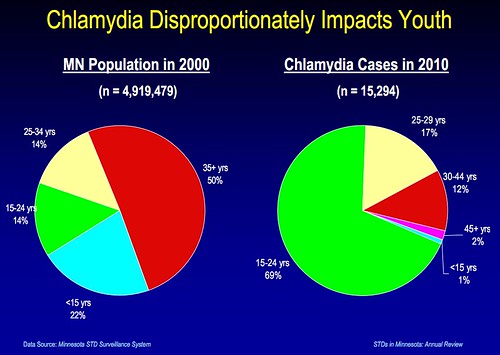 >How great is the need for family planning services? With the prevalence of abstinence-only education, many sexually active teens and young adults never receive medically accurate sex education. Not knowing how to protect themselves, they are much more likely to have unprotected sex. This has lead to an increase in STIs in Minnesota and the United States. Approximately 1 in 2 Americans will contract an STI at some point in their lifetime with 1 in 4 teens contracting an STI each year. Considering that less than half of adults 18-44 have EVER been tested for an STI (other than HIV), these numbers are staggering. In Minnesota, STI rates increased by 5% in 2010 - chlamydia 6%, syphilis 110% and gonorrhea decreased by 9%. The incidence rate of chlamydia has more than doubled since 1996 and tripled for those 25-39. The incidence of chlamydia infection among minority groups ranges from 2.5 to 15 times the incidence of white Minnesotans. In 2009 alone, there were 370 new HIV cases reported in Minnesota - every day last year, someone found out they were HIV positive. Teen pregnancies already account for a large percentage of births, especially in rural areas and over half of all MFIP (MN welfare program) dollars go to families that begin with a teen parent.
>How great is the need for family planning services? With the prevalence of abstinence-only education, many sexually active teens and young adults never receive medically accurate sex education. Not knowing how to protect themselves, they are much more likely to have unprotected sex. This has lead to an increase in STIs in Minnesota and the United States. Approximately 1 in 2 Americans will contract an STI at some point in their lifetime with 1 in 4 teens contracting an STI each year. Considering that less than half of adults 18-44 have EVER been tested for an STI (other than HIV), these numbers are staggering. In Minnesota, STI rates increased by 5% in 2010 - chlamydia 6%, syphilis 110% and gonorrhea decreased by 9%. The incidence rate of chlamydia has more than doubled since 1996 and tripled for those 25-39. The incidence of chlamydia infection among minority groups ranges from 2.5 to 15 times the incidence of white Minnesotans. In 2009 alone, there were 370 new HIV cases reported in Minnesota - every day last year, someone found out they were HIV positive. Teen pregnancies already account for a large percentage of births, especially in rural areas and over half of all MFIP (MN welfare program) dollars go to families that begin with a teen parent. Failing to educate our youth feeds back into these patterns of increased incidence of STIs and more unplanned pregnancies. Undiagnosed and untreated STIs can even lead to lifelong health problems or death. STIs can damage organs (reproductive, heart, joints and brain), increase the risk of infertility and tubal pregnancy, increase the risk of birth defects or stillborns, and increase the risk of transmitting or getting HIV.
STIs are preventable and many are easily treated. While the best prevention method is abstinence, consistant and correct usage of latex condoms is a highly effective method to prevent HIV and STI transmission. Vaccines are also available to prevent hepatitis A, hepatitis B and HPV (the viruses that cause genital warts and cervical cancer). Removing funding for highly efficient public health programs - every dollar spent on family planning services saves taxpayers four dollars in other state medical spending - is short-sighted and ignores 32 years of effective bipartisan public policy. All Minnesotans should have the knowledge and resources to prevent unintended pregnancies. Eliminating state funding and blocking federal funding for family planning in Minnesota will result in more unintended pregnancies, increases in incidence and complications from STIs, and will disproportionately hurt the poor and the youth of Minnesota.
Regular STI testing helps catch infections at early stages. href=" http://sexualhealthmn.org.">Get tested!
Statistics for this post were found at the CDC and MDH
Image from MDH
Cross-posted from Planned Parenthood Advocate: http://www.plannedparenthoodadvocate.org/content/education_and_access_to_family_planning_can_reduce_sti_cases_in_mn
No comments:
Post a Comment